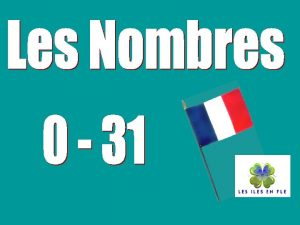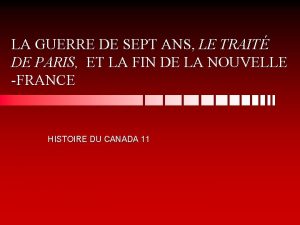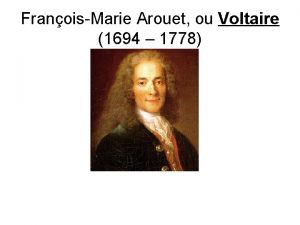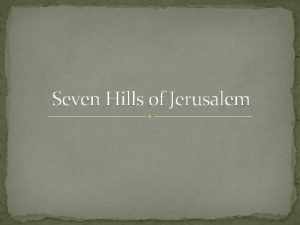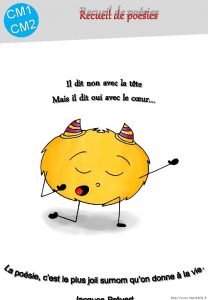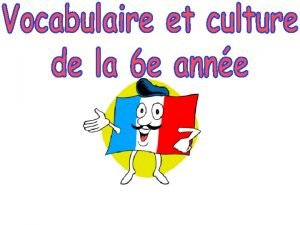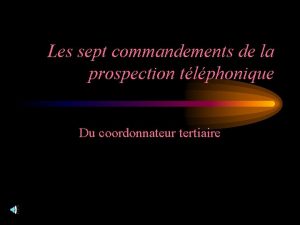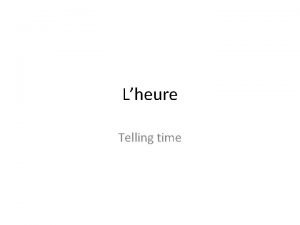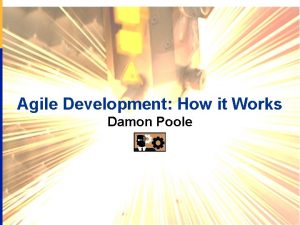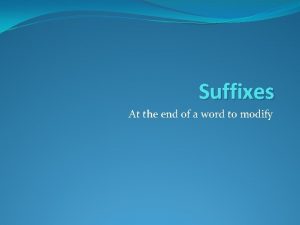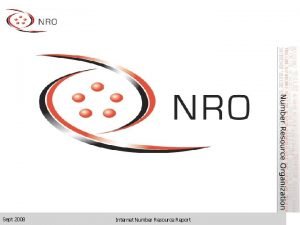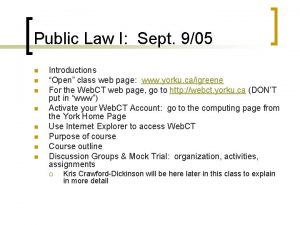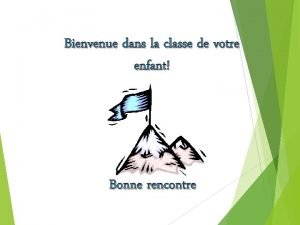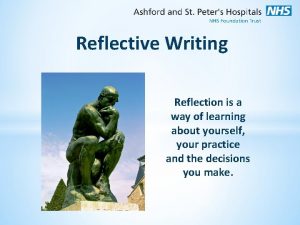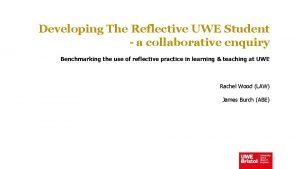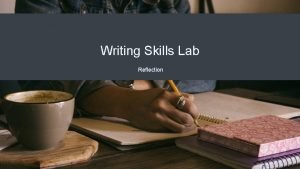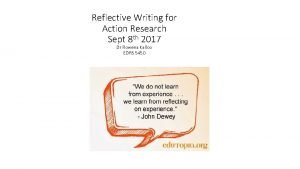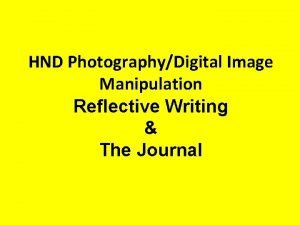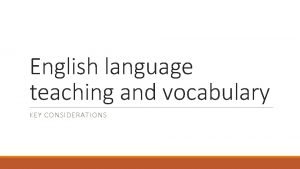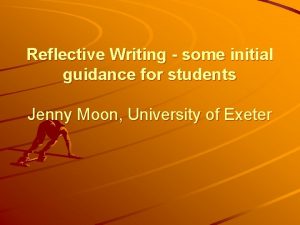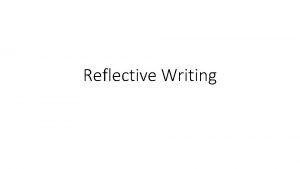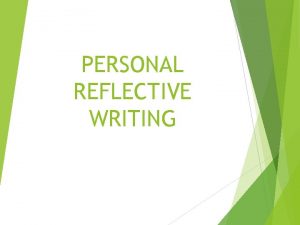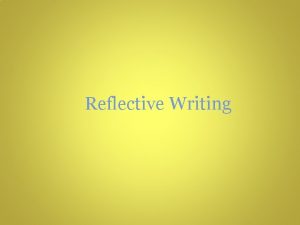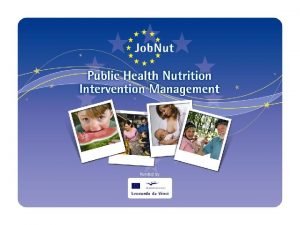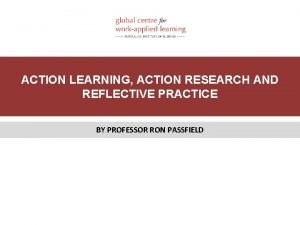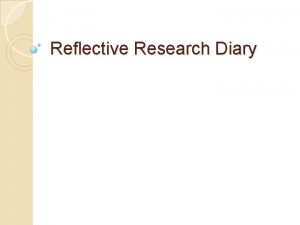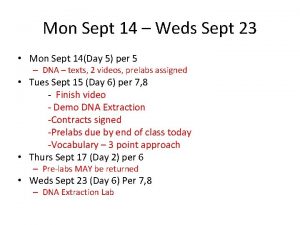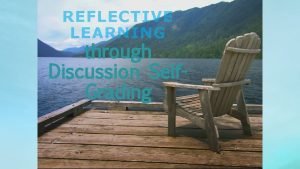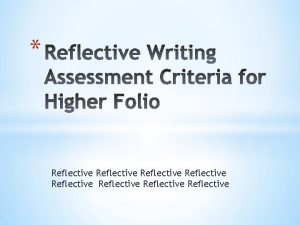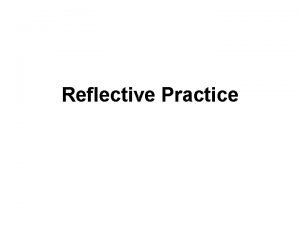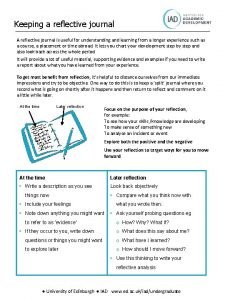Reflective Writing for Action Research Sept 8 th




















- Slides: 20

Reflective Writing for Action Research Sept 8 th 2017 Dr Rowena Kalloo EDRS 5450

At the end of this session you should be able to: • Describe the role of reflection in the AR Cycle. • Distinguish Schon’s reflection in action from reflection on action. • Identify the stages of the DIEP for writing academic reflections. • Understand the requirements of the journal entries 1, 2, 3. • Write a practice entry for Journal 1.

Session outline • 1. Review concepts of Action Research: definition, models, Identification of reflection within the AR cycle. • 3. Review what you have learnt about Reflection – What is it? Why reflect? • 4. Analyse the place of reflection in David Kolb’s Reflective model. • 5. Interrogate Schon’s ideas of reflection – Reflection in action, reflection on action. • 6. Review the requirements of the journal entries. • 7. Practice session – responding to journal entry 1.

How would you define Action Research? Read the definitions on the next slide which were presented by Dr Freddy. Think about how these definitions are alike and different. Pair/ Share your thoughts with a partner. Share/ Then share thoughts with the large group.

Defining Action Research – Dr Freddy James • Action research- systematic enquiry designed to yield practical results capable of improving a specific aspect of practice and made public to enable scrutiny and testing (DCSF). • ‘Action research is a form of collective self-reflective enquiry undertaken by participants in social situations in order to improve the rationality and justice of their social or educational practices, as well as their understanding of these practices and the situation in which these practices are carried out’. • (Kemmis and Mc. Taggart. 1988, p 5)

Comparing definitions • Both definitions emphasise Action Research as a form of Enquiry. • Both definitions refer to the outcomes of Action Research as Improving Practice. • However in Definition 2 – Enquiry is collective and involves self reflection. • Dr James introduced you to the Kemmis and Mc. Taggart model of Action Research on the next slide.

A Model of Action Research – Kemmis & Mc Taggart(1998). What is the role of reflection in this model?

Reflection • Reflection and action have a dynamic interaction. • Reflection shapes the planning and implementation of action research. • But • What do we mean by reflection? • How does it occur? • What are its benefits? • What are its challenges? • Share your thoughts based on your previous work on reflection with Mrs Juliet Jones. • Now look at the video in the next slide. What further insights does Kolb bring to the concept of reflection in teaching? (Press the hand for the video to pop up)

The practice of reflection in Teaching: Kolb’s cycle

What insights does Kolb bring to our understanding of teaching and learning? • David Kolb brought out ideas of reflection which removed the separation between research and learning. Learning was a form of research. • Teachers and students are continually learning from their experience – experiential learning. • Reflection occurred in practical situations in the classroom. • Reflection involved thinking about our practice. • Reflection allowed us to change or adapt our practice. • Reflection came after practice – single loop learning. • The process of learning/adapting and reflection is cyclical.

Donald Schon – The Reflective Practitioner • Schön, D. (1983) The Reflective Practitioner. How professionals think in action. • Schon (1930 -1997) – focused on the work of the practitioner specifically. Schon critiques the Technical-rational model of knowledge. This model emphasises teaching as filling students with technical skills and knowledge. This model did not take into account the complex and messy nature of learning and teaching.

Schon – Different types of practitioner’s knowledge. • Schon unlike Kolb argued that practitioners reflected in different ways. • 1. Tacit knowledge-knowing in action – this refers to almost intuitive ways of acting, parts of our routine that we do smoothly, often unaware that they are framed by a theory of action. • 2. Reflection in action: occurs as we teach. We are continually encountering situations while teaching and adapting to those situations by thinking on our feet. This involves quickly assessing the situation, drawing on present and previous data and making a decision. • 3. Reflection on action: this occurs after we teach. It is a more thoughtful and deliberate reflection. We take time and space to think carefully about our actions and plan for change.

Single vs double loop learning • Kolb’s theory was based on single loop learning. • We reflect on our actions and change our behaviours. • Schon and Argyis (1976) argued that we do not only reflect on our mistakes, but we can reflect on our assumptions. • We can adjust our professional behaviours by unearthing the assumptions behind these actions.

How do you reflect? Think of the three types of reflection described by Schon. Which of these do you recognise in your practice? Look at the journal entry requirements. What type of reflection are you asked to take part in when writing journals? When are you doing the journal reflections? What might be the usefulness of doing journals at each of these points in your research?

Journal Writing for Action Research The Journal allows us to reflect on Action research is messy, it is not a straight path from question to conclusion. We will be reflecting in action as we teach and plan, but we need to give ourselves a space for more in-depth reflection at critical points on our journey. These entries help us to clarify our intentions, unearth our assumptions, and give us confidence in moving forward. Journal entry 1 (beginning) – focuses our attention on the conceptualisation of the study. What factors were influencing our choice of study? Journal entry 2 (middle) – focuses on the implementation – why are we choosing this form of intervention? Journal entry 3(end) – asks us to reflect on the process we have just gone through. What have we learnt? Was it useful? What would we do in the future?

Writing a journal entry – what is the mother’s problem? Is it really a problem?

Reflective writing • Reflection is not simply description. • When we reflect we question ourselves, interpret our situation, evaluate and draw conclusions. • The DIEP model provides a useful frame for reflective writing.

Reflective writing activity – DIEP • Describe, Interpret, Evaluate, Plan ( state relevance to your practice) • Describe the incident • Interpret the incident – What might it mean? Why might it have occurred? • Evaluate – what was important or valuable about this experience? • Plan – How might this incident be relevant to your future practice? How will it help you plan for the future? • Activity: Review the examples of DIEP – Banana Bread making and Teaching a blind student. Do you agree with the DIEP categories?

The Action Research Reflective Journal • You will need: • Journal prompts • Journal rubrics Task – In your group discuss share your research foci. Chose one person’s research topic. As a group write a journal entry which responds to the first two prompts for Journal entry 1. Do not just describe – try to interpret, evaluate and plan. • Share with colleagues • Give the entry a grade based on the rubric • Discuss the criteria used for grading. • Due date for Journal Entry 1 – October 13 th 2017. • •

Thank you for your participation
 Un, deux, trois, quatre, cinq, six, sept, huit, neuf
Un, deux, trois, quatre, cinq, six, sept, huit, neuf Deportes
Deportes Candide ou l optimisme
Candide ou l optimisme How many hills is jerusalem built on
How many hills is jerusalem built on Poésie le dernier sapin mr truchi
Poésie le dernier sapin mr truchi Ecrivez les sept jours de la semaine
Ecrivez les sept jours de la semaine Sept commandements
Sept commandements Cnn 10 sep 7
Cnn 10 sep 7 Sept heure moins le quart
Sept heure moins le quart Accu poole sept
Accu poole sept Suture to stabilize suffix
Suture to stabilize suffix Sept
Sept I sept
I sept Sept comme setteur questionnaire
Sept comme setteur questionnaire Atkins and murphy reflective model
Atkins and murphy reflective model Uwe reflective writing
Uwe reflective writing What is a reflection in writing
What is a reflection in writing Diep reflection
Diep reflection Reflective writing images
Reflective writing images Reflective writing vocabulary
Reflective writing vocabulary Jenny moon reflective writing
Jenny moon reflective writing
